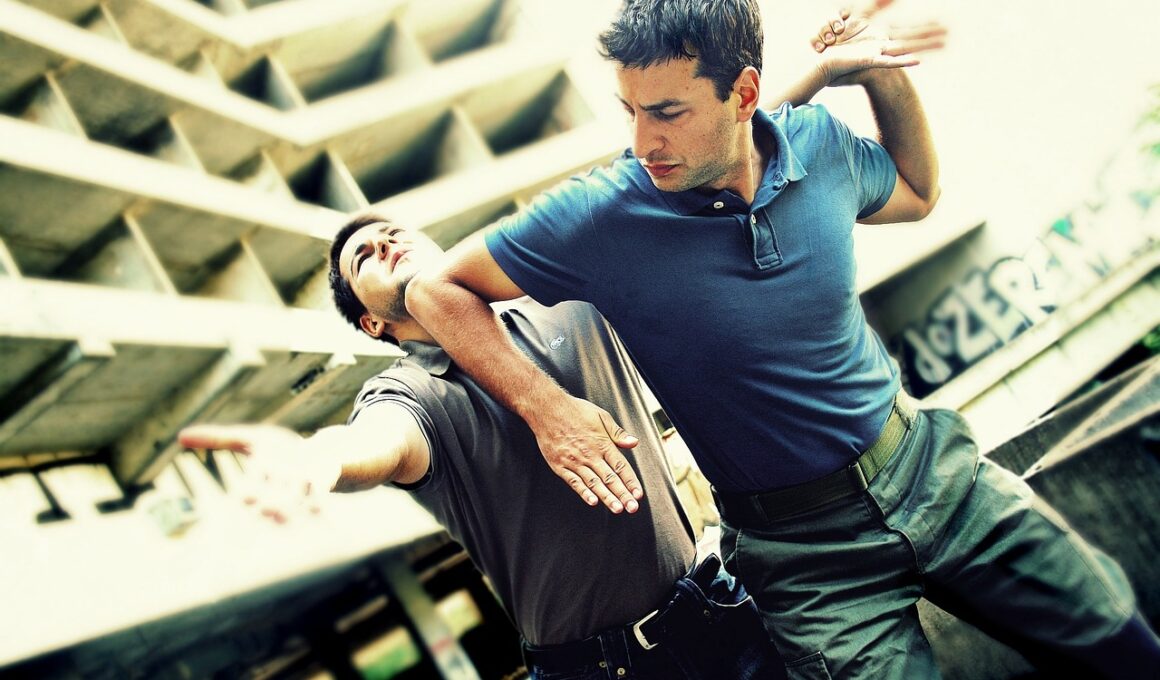Tutorial on Clinch Fighting Techniques and Control
In martial arts, clinch fighting refers to a close-range combat style where fighters grapple and control their opponent. Mastering the clinch is crucial for enhancing your self-defense skills and developing effective techniques in various scenarios. The clinch can be employed in different martial arts systems, such as wrestling, Muay Thai, and Brazilian Jiu-Jitsu, among others. It’s essential to understand the main concepts of clinch fighting, including body positioning, grip techniques, and maintaining balance. Also, recognize the importance of establishing control over your opponent’s body, which will give you a considerable advantage in a fighting situation. This tutorial will guide you through key aspects of clinch fighting, focusing on principles of positioning and effective techniques. Additionally, we will cover the significance of maintaining a strong structure in the clinch and executing various movements to thwart your opponent’s actions. Understanding how to maintain posture while engaging in the clinch is vital for successful techniques. Engage in practice sessions to develop your unique style of clinch fighting and become more proficient in self-defense situations.
Once you have a solid grasp of basic clinch principles, delve into various clinch techniques designed to give you an edge in combat. Some fundamental techniques include the double underhook, overhook, and neck tie. Each technique has its distinct application and advantages based on your opponent’s position. The double underhook is particularly useful as it focuses on securing both opponents’ arms, rendering them helpless. Furthermore, using the overhook allows you to control your opponent’s arm from above. The neck tie technique can create an opportunity for advanced strikes, leveraging angles to execute powerful knees or elbows. It’s crucial to experiment with each technique during sparring sessions to identify your preferences and strengths. Using these techniques effectively requires understanding timing and sensitivity to your opponent’s movements and intentions. Another effective element is footwork; proper footwork can help you maneuver into advantages while in the clinch. Practicing footwork drills will also allow you to maintain your balance and create openings for transitions into takedowns or strikes. Integrate these techniques into your training routine for well-rounded skill development.
Body Control and Balance in the Clinch
A fundamental aspect of clinch fighting is maintaining body control and balance, which are vital components influencing the fight’s direction. By focusing on your center of gravity and stance, you can improve your ability to withstand heavy resistance from opponents. Practicing the stance during drills enables you to feel grounded and connected to the surface while performing clinch techniques. Balance allows you to respond effectively, enabling swift movements and counterattacks. Additionally, using hip movement effectively contributes to control while in the clinch, making it difficult for opponents to execute their techniques. Wisely selecting when to pull or push into your opponent will dictate the fight’s flow, creating openings for counterattacks or takedowns. Focusing on hip movement during practice ensures that you remain in a favorable position while maintaining pressure and control over the opponent. Regularly work with training partners of varying skill levels, which challenges you to adapt your techniques based on their responses. Developing both body control and balance takes time and consistency; however, fully committing to training will provide you with substantial benefits.
Strategizing within the clinch environment not only enhances your martial arts capabilities but also promotes critical thinking during fights. Effective decision-making empowers you to adjust your tactics based on your opponent’s behavior. Envision real-time scenarios where various control techniques can be employed, leading to striking opportunities or takedowns. It’s essential to think about possible escapes the opponent may utilize, preparing your responses in advance. Another key point to focus on is the psychological aspect of the clinch; recognizing the pressure you can exert over your opponent’s mental state is crucial. Applying these strategic principles helps develop a sense of confidence, making you more effective in sparring or competition. You should also pay attention to the transitions from clinch to stand-up positions or ground control and vice versa. As you train, attempt to shift quickly between these elements, practicing fluid movement and seamless transitions. The goal is to become adaptable in various fighting scenarios, reaping benefits in both self-defense and martial arts competitions. Proper practice and mindset are paramount in strengthening your clinch game.
Drills and Sparring for Clinch Techniques
Practical application through drills and sparring is vital for solidifying your clinch techniques. Engaging in specific drills allows you to refine your movements while focusing on control, balance, and technique execution. Start with partner drills, where you practice securing different clinch positions and transitioning between them. Another effective practice approach includes timed-out sparring sessions focusing solely on clinch fighting. This method assists in understanding the nuances from a reactive standpoint. Examples of effective drills include the active clinch drill, where a fighter engages in clinch exchanges for a set duration, reinforcing various techniques back and forth. Additionally, using resistance bands during solo training can enhance your grip strength, providing vital support for clinching techniques. Take note of how each drill affects your performance over time. Tracking your progress can help in identifying areas requiring more focus or improvement. Remember that being patient and diligent during practice is essential for mastery. Consistent engagement with drills will lead to greater fluency and confidence in executing clinch techniques during sparring or matches.
Incorporating strength training into your routine can significantly enhance your clinch fighting capabilities. A well-rounded strength program should target muscle groups essential for maintaining effective control in the clinch. Focus on exercises that strengthen the core, legs, and shoulders, as these areas contribute greatly to your balance and gripping power. Examples of beneficial exercises include squats, deadlifts, and overhead presses. Additionally, integrating resistance training and functional movement patterns will produce better results. Use tools such as kettlebells or resistance bands to develop strength while mimicking the specific actions involved in clinch fighting. Stretching and flexibility training are equally important in enhancing your range of movement and overall power outputs. Activities such as yoga or dynamic stretching should be employed regularly to improve flexibility. The combination of strength training and flexibility will help ensure your body is well-prepared to adapt quickly when engaged in clinch situations. Assess your performance continually, and consult with a trainer when necessary for personalized advice on your training regimen. Emphasizing strength training in your routine will lead to improved skills in clinch fighting techniques.
Conclusion and Future Direction in Clinch Techniques
Practicing clinch fighting fosters not only physical abilities but also psychological resilience necessary for effective self-defense. Consistently applying techniques learned throughout this tutorial is crucial for your overall development as a martial artist. Make use of the various techniques discussed to build your unique style and identify areas of strength. Training with partners will help reinforce invaluable skills while exposing you to different fighting styles, enabling you to adapt and think critically under pressure. Be open to feedback from your trainers or coaches; this will assist you in refining your techniques and enhancing your knowledge. The next step is to explore more advanced clinch tactics, additional transitions, and competitions, applying everything you have learned in real-life scenarios. Having a network of training partners and experienced mentors is vital for your growth as self-defense techniques become ingrained. Embrace the challenging aspects of training as it contributes to resilience and self-confidence. Finally, continually educate yourself through classes, seminars, and instructional videos to broaden your understanding, ensuring you stay updated on the latest trends and developments in clinch fighting techniques.
Ultimately, the journey of mastering clinch fighting never truly ends, as there is always room for improvement and exploration. Commit yourself to never stop learning and remain aware of the evolutions in martial arts fighting techniques. This continuous pursuit will cultivate a mindset for growth, ensuring you stay versatile and capable of addressing diverse opponents effectively. Implement new strategies regularly, reassessing and revising what aspects to refine. Encourage your fellow martial artists throughout this journey to create an uplifting training environment that fosters growth and improvement. Share knowledge and experiences as they can bring about different perspectives we might overlook. Analyze videos of professional fighters in the clinch–this will offer insight into receiving techniques and adapting your style accordingly. Remember to maintain a balance between strength and technique, as both are fundamental components of effective clinch fighting. Stay inquisitive in your training approach, and engage with other martial artists to expand your understanding. Above all, embrace the consistent practice and effort, and you will undoubtedly notice substantial progress as you develop your clinch fighting skills.


